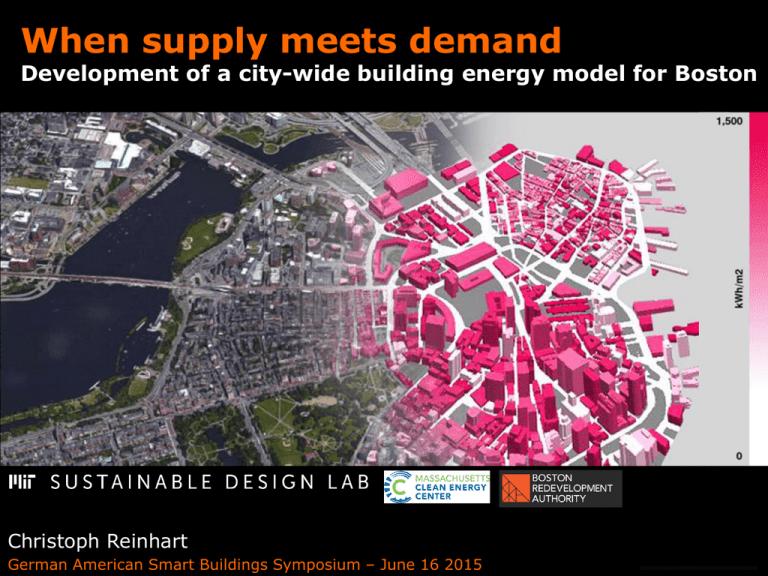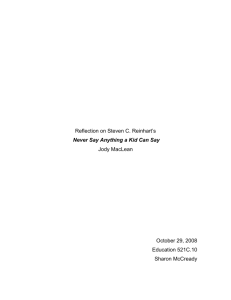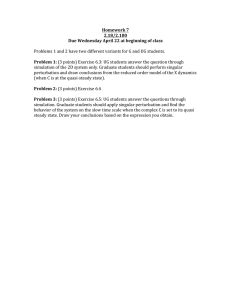Massachusetts Institute of Technology
advertisement

When supply meets demand Development of a city-wide building energy model for Boston Christoph Reinhart German American Smart Buildings Symposium – June 16 2015 Brianne Coston (BS) Carlos Cerezo (PhD) Timur Dogan (PhD) Ali Irani (BS) Nathaniel Jones (PhD) Aiko Nagano (SMBT) Christoph Reinhart Cody Rose (SMBT) Tarek Rakha (PhD) Manos Saratsis (SMARCHS) Julia Sokol (MechE) “Our research goal is to change current sustainable design practice by developing, validating and testing workflows and metrics that lead to improved design solutions as far as occupant comfort and health as well as building energy use are concerned. The premise of this work is that an informed decision is a better decision.” web.mit.edu/SustainableDesignLab Building Performance Simulation Building Performance Simulation: An computer-based attempt to model the various energy and mass flows within a building in order to predict one or several performance aspects of a design. Operational Energy Return on Investment Solar Radiation Occupant Comfort Daylight Walkability Why BPS? To demonstrate code compliance and to reduce risk. (Think of LEED Green building Certification.) To compare different design variants. How often does that happen? Question to Architects: “How frequently do simulation results influence the design of your buildings?” Paper H W Samuelson, A Lantz and C F Reinhart, "Non-technical barriers to energy model sharing and reuse", Building and Environment, 54, pp. 71-76, 2012. Do today’s simulation programs work? ASHRAE thinks so. Purpose of the Standard Analyzing and diagnosing building energy simulation software using software-to-software and software-toanalytical-solution comparisons. Checking a program against a previous version of itself after internal code modifications such as an algorithmic change. ASHRAE 140 -2007 Standard Method for the Evaluation of Building Energy Analysis Computer Programs Uncle Sam thinks so, too. Tax Deduction Information Under IRS rules, taxpayers' building energy use performance must be calculated using software that has been tested according to ANSI/ASHRAE Standard 140 to qualify for tax deductions. Comparison of measured and simulated energy use for 97 LEED Buildings Model uncertainty from weather, infiltration rate, usage schedule and occupant behavior. Paper H W Samuelson, A Lantz and C F Reinhart, "Non-technical barriers to energy model sharing and reuse", Building and Environment, 54, pp. 71-76, 2012. But, models can be calibrated 450 DesignPhase Models Measured EUI (kWh/m2) 11 350 7 15 10 8 18 Final PartiallyCalibrated Models 1 16 250 4 9 12 6 13 17 14 2 150 # Building Number 5 3 450 350 250 150 50 50 Predicted EUI (kWh/m 2) Paper: H W Samuelson, A Ghorayshib & C F Reinhart, 2014, “Analysis of a Simplified Building Energy Model Calibration Procedure for 18 Real-World Case Studies, submitted to the Journal of Building Performance Simulation Urban Modeling Our task is to house 1.6 billion new city dwellers in 16 years or two million a week. *) Grimond, J, 2007, The world goes to town, The Economist, May 5th 2007 Source: WIKI UN 2010 Projections From homo sapiens to homo urbanus* How do we live? Goal To develop an urban modeling platform to design and improve new and existing neighborhoods regarding multiple measures of urban sustainability including operational energy use, daylighting, outdoor comfort and sustainable transportation. Informal Settlement in Rio Suburbs in Shanghai Operational Energy Operational Energy Mobility Mobility Comfort Comfort Back Bay, Boston Daylight Daylight Costs Costs Embodied Energy Embodied Energy Forum Vaubin, Freiburg, Germany Combining Big Data and BPS Photo of the MIT Campus (Google Maps). LiDAR Data of the MIT Campus 3 dimensional point cloud (126 million points). 3D Model of the MIT Campus Generation of a 3D model through surface triangulation. Solar Radiation Map Cumulative annual solar radiation. mapdwell LLC DIVA DAY 2013 at Thornton Tomasetti, NYC In 2013 we formed an MIT spinoff that develops interactive maps to predict the potential to install PV on urban rooftops. http://en.mapdwell.com/ In 2014 the mapdwell map of Wellfleet, MA, supported a communitydriven solarize program: Within 3 months 10% of all households went solar. umi BT Weather station on top of the MIT Green Building The new LEED Daylighting Credit based on spatial Daylight Autonomy was originally developed by Christoph Reinhart and is now formalized into a IESNA Lighting Measurement Standard. umi version 2.0 was released in November 2014. http://urbanmodellinginterface.ning.com/ Workflow umi is a plugin for the NURBS Modeler Rhinoceros 5 Paper: C F Reinhart T Dogan, J A Jakubiec, T Rakha, A and A Sang, “umi – An urban simulation environment for building energy use, daylighting and walkability,” Proceedings of Building Simulation 2013, Chambery , France, August 2013. Workflow umi converts an urban massing model… Workflow … into an urban energy model… Workflow … which can be used as a design tool to improve individual or groups of buildings … Workflow Cumulative Electricity and Gas Use for a Neighborhood … or to develop better energy supply solutions such as microgrids. How does it work? 1. Design a building form 2. Assign energy templates and 3. Simulation model constructed fenestration information Paper: C Cerezo, T Dogan and C F Reinhart, “A New Library File Format and Tool for Building Simulation Template Editing, Management and Exchange,” Proceedings of 2014 ASHRAE/IBPSA-USA Building Simulation Conference, Atlanta, GA, September 10-12, 2014 Autozoner Improved Zoning Algorithms Paper: T Dogan, C F Reinhart and M Panagotis, “Autozoner: An algorithm for automatic thermal zoning of buildings with unknown interior space definitions,” Journal of Building Performance Simulation (in press) How reliable are the resulting urban building energy models (UBEM)? UBEM Workflow Block 8 Al Quidiziah, Kuwait City SECTION 8 18 blocks 220 villas 205,000 m2 Al Qadisiyah district, Kuwait City 200 houses Measured Energy Use Paper: C Cerezo, J Sokol, C F Reinhart, A Al-Mumin, “Comparison of three methods for the characterization of building archetypes in urban scale energy simulation. The case study of a residential neighborhood in Kuwait,” submitted to Building Simulation 2015 Block 8 Al Quidiziah, Kuwait City 1 Building Type from Literature Paper: C Cerezo, J Sokol, C F Reinhart, A Al-Mumin, “Comparison of three methods for the characterization of building archetypes in urban scale energy simulation. The case study of a residential neighborhood in Kuwait,” submitted to Building Simulation 2015 Block 8 Al Quidiziah, Kuwait City 2010s code villa 1960/70s retrofitted villa Different Building Types from Neighborhood Walkthroughs Paper: C Cerezo, J Sokol, C F Reinhart, A Al-Mumin, “Comparison of three methods for the characterization of building archetypes in urban scale energy simulation. The case study of a residential neighborhood in Kuwait,” submitted to Building Simulation 2015 Block 8 Al Quidiziah, Kuwait City Savings form retrofitting measures 1 Building Type from Literature 4 Building Types from Neighborhood Walkthroughs Occupancy Behavior Model Paper: C Cerezo, J Sokol, C F Reinhart, A Al-Mumin, “Comparison of three methods for the characterization of building archetypes in urban scale energy simulation. The case study of a residential neighborhood in Kuwait,” submitted to Building Simulation 2015 Net Zero Growth Aiko Nakano, Denise Rivas, Manos Saratsis, Julia Sokol MIT Office For Sustainability Modeling the MIT Campus Testing SIMLIB MIT Campus Energy Model MIT campus energy model (Source: Nakano A, D Rivas, E Saratsis and J Sokol, 2014) Paper: C F Reinhart, “Managing Building Energy-Efficiency at the Neighborhood/Campus Level,” MIT Energy Initiative White Paper for: Large Opportunities, Complex Challenges: Seizing the Energy Efficiency Opportunity in the Commercial Buildings Sector, May 2014. Boston Building Energy Study In collaboration with the Boston Redevelopment Authority with support from the Massachusetts Clean Energy Center we are scaling our modeling capabilities up to whole cities. The final Boston model will include over 100,000 buildings. Together with Lincoln Laboratory we are exploring new energy supply technologies for Boston such a mircogrids and district heating/cooling. Embodied Energy Source: Carlos Cerezo Embodied Energy umi can also be used to predict the embodied energy use of a neighborhood. Paper: C Cerezo and C F Reinhart, “Urban energy lifecycle: An analytical framework to evaluate the embodied energy use of urban developments,” Proceedings of Building Simulation 2014, Chamberry, France, August 2013 Daylighting Other outputs are access to daylight throughout a neighborhood,… Paper: T Dogan and C F Reinhart, “Urban daylight simulation: Calculating the daylit area of urban designs’,” Proceedings of SimBuild 2012, Madison, Wisconsin, USA umi - Outdoor Comfort Tair > 28 °C & dir solar Tair < 5 °C & without dir solar hours / yr … outdoor comfort conditions throughout the year,… hours / yr Riyadh Study – Interactivity Impression for a test use of the interface at the ADA in March 2015 Between 2013 and 2015 we collaborated with the KACST-MIT CCSE and the MIT Media Lab on a tangible user interface that supports the interactive development of sustainability concepts by non-experts based on building energy costs, access to natural light and walkability suing a custom Saudi-Index. Paper: C M Rose, M Saratsis, S Aldawood, T Dogan , C F Reinhart, “A tangible interface for collaborative urban design for energy-efficiency, daylighting and walkability,” submitted to Building Simulation 2015 Closing Thoughts Information based design (using BPS) is diffusing into decisionmaking processes at all levels related to the built environment from architecture to urban planning and policy. We need to educate stakeholders, practitioners and students as to what the capabilities and limitations of these tools are. BPS will become a common tool linked to GIS and BIM to design and maintain our built environment. Thank You Contact Christoph Reinhart Associate Professor MIT Email: creinhart@mit.edu MIT Sustainable Design Lab Carlos Cerezo Timur Dogan Jeff Geisinger Nathaniel Jones Aiko Nagano Tarek Rakha Cody Rose Manaos Saratsis Julia Sokol Modeling Urban Sustainability - Energy, Daylight and Walkability August 17-21 2015 Ex Ed Program MIT Architecture http://architecture.mit.edu/event/modeling-urban-sustainabilityenergy-daylight-and-walkability Solemma LLC Alstan Jakubiec Kera Lagios Jeff Niemasz Jon Sargent Mapdwell LLC Eduardo Berlin Alstan Jakubiec Nicolás Waissbluth Alumni Karthik Dondeti, Elliot Glassman, Seth Holmes, Cynthia Kwan, Diego Ibarra, Alstan Jakubiec, Rohit Manudhane, Rashida Mogri, Azadeh Omidfar, Debashree Pal, Krista Palen, Tiffany Otis, Holly W Samuelson, Jennifer Sze, John Sullivan



